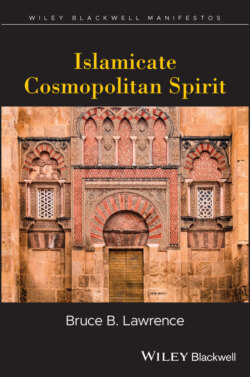Читать книгу Islamicate Cosmopolitan Spirit - Bruce B. Lawrence - Страница 18
Notes
Оглавление1 1 See below, Huricihan Islamoğlu, “Islamicate World Histories?” in Douglas Northrup, ed., A Companion to World History (Oxford: Wiley-Blackwell, 2012): chapter 30, 447–463. She begins the final section (457–460) with the further query: “Can We Write World Histories that are Genuinely World Histories?”.
2 2 Edmund Burke III observed that Hodgson had an unpublished book-length work, “The Unity of World History,” which remains unpublished, though the last three chapters of that liminal work were published as Part III of Marshall G.S. Hodgson, Rethinking World History: Essays on Europe, Islam and World History (Studies in Comparative World History) (E. Burke, ed.). (Cambridge: Cambridge University Press, 1993): xi and 247–299. Edmund Burke III and Robert Mankin, eds., Islam and World History: The Ventures of Marshall Hodgson (Chicago, IL: University of Chicago Press, 2018), dedicates Part One to “Hodgson and World History.” It consists of four essays, by Michael Geyer, Katja Naumann, C.A. Bayly, and Pamela Crossley. Along with other revisionist historians, I am indebted to Burke for his decades-long dedication to popularizing and expanding the legacy of Hodgson as a world historian.
3 3 Burke/Hodgson (1993): 70–71. While Hodgson did not know Enrique Dussel, it is impossible to imagine that he would not have agreed with Dussel’s insight that European modernity is itself ambiguous, bifurcated rather than unified in its role as a modern colonial project. A leading Mexican philosopher and world historian, Enrique Dussel depicts not one but two major forms of modernity. Hispanic modernity or Modernity I was centered in Seville. It projected a mercantilist and monetary expansion of Portuguese—but even more, Spanish—influence that included missionary projects on behalf of the Roman Church from Latin America to East Asia. It was succeeded in the mid-17th century by Modernity II, centered first in Amsterdam but then recentered from the 18th century on in England and Scotland. It was mercantilist and bourgeois, advocating Christianity as in Modernity I, but sending Protestant rather than Catholic missionaries to the marginalized, colonized world. Major regions, but also all the major religions, were affected by this two-pronged emergence of European Modernity, none more so than Islam and the Muslim societies of Asia and Africa, or what Hodgson calls the Afro-Eurasian ecumene. See Enrique Dussel, “The Sociohistorical Meaning of Liberation Theology (Reflections about Its Origin and World Context)” in David N. Hopkins, Lois Ann Lorentzen, Eduardo Mendieta, and David Batstone, eds., Religions/Globalizations—Theories and Cases (Durham, NC: Duke University, 2001): 34–35.
4 4 Huricihan Islamoğlu, “Islamicate World Histories” in Douglas Northrup, ed., A Companion to World History (Oxford: Blackwell, 2012): chapter 30, 447–463, here summarized to fit my argument for Islamicate cosmopolitan as a pervasive element of world history.
5 5 The complete text of Islamoğlu’s (2014) WOCMES paper can be found at: https://www.academia.edu/37842112/ISLAMOGLU_Marshall_Hodgson_and_WorldHistoryas_Fulfillment_of_Individual_Moral_Responsibility.pdf (accessed June 24, 2020).
6 6 Jocelyne Dakhlia, “Harems and Cathedrals: The Question of Gender and Sexuality in the Work of Marshall Hodgson” in Burke and Mankin (2018): chapter 8. Also noteworthy is that the most accessible summary digest of The Venture of Islam was provided by Hodgson’s last PhD student, herself a brilliant female comparativist. See “The Islamic World,” an epitome by Marilyn Waldman, along with Malika Zeghal, in Encyclopaedia Britannica online (accessed on May 30, 2020).
